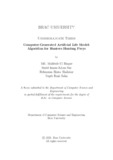Computer-generated artificial life model: algorithm for hunters hunting preys
Abstract
This thesis simulates the behavior of predators and preys observed between a pack
of wolves and a deer herd during a hunting scenario. We use the Boids flocking
algorithm, an artificial life model developed by Craig Reynolds to simulate the deer
herd. We have also enriched the existing algorithm to help flocks recognize their
surroundings, like their neighbors and predators, and react accordingly. The pack of
wolves has a leader, and they coordinate as a group isolating a deer from the herd and
then capturing it. To implement the predator’s behavior and intelligence, we have
developed some algorithms applying their hunting procedure. A part of the research
is to explore simple rules that the wolves can follow to achieve their hunting goals.
We have also worked on the concept of the Convex Hull algorithm, that can help
the predators define their attack positions. Interruptions in the hunting environment
between prey and predators that affects the actions of preys and predators have also
been studied. In this experiment, actions by the prey and predators are compared
in terms of realism.

